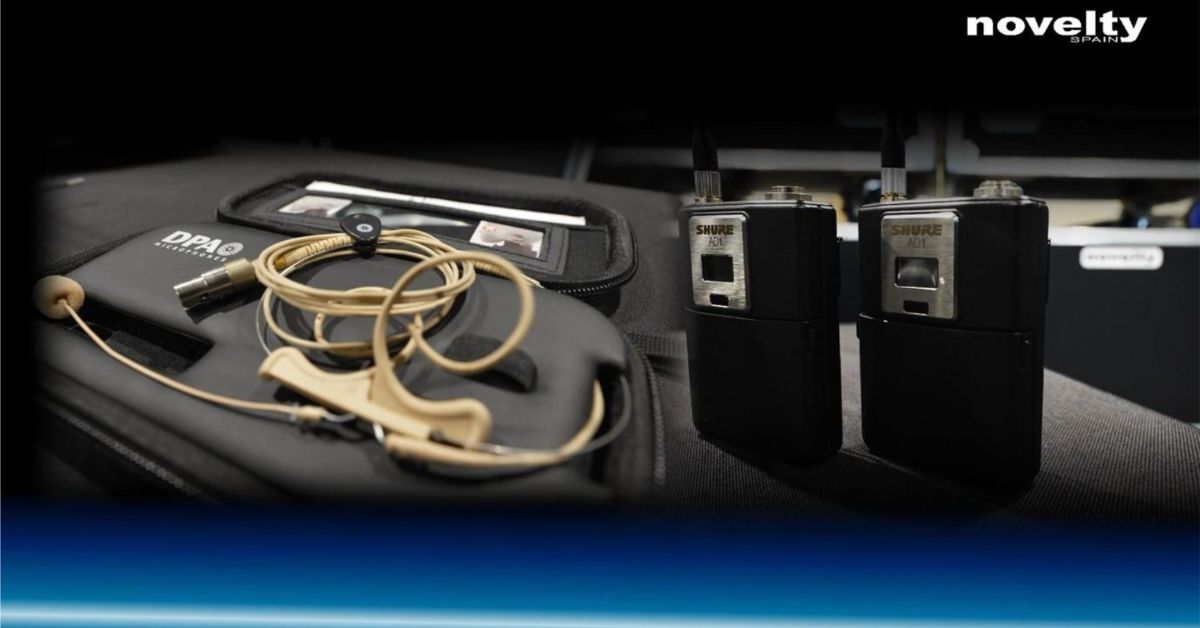- Event AV Services
- Audiovisual Technical Production
- Event Projection Mapping
- Broadcast Services and Live Streaming for Events
- Scenography Design for Events
- Audiovisual Content for Events
- 3D Renders, Interactive Application and VR for Events
- Event AV Services
- AV Consultancy and AV System Integration
- Venue AV Partnership
- AV Equipment Rental
- AV production for events by industry
- AV production by event types
- AV production for venues
- AV Resources
- Global Presence
- Company
- Contact
Different types of microphones for events and how to choose the right one
In event planning, sound is one of the most important elements needed to ensure a flawless experience. A professional sound system starts with choosing the right microphone. Whether it’s a corporate conference, a brand presentation or a live show, selecting the correct microphone for events makes the difference between delivering a clear message and facing an event full of feedback and interruptions.
In this article, we’ll breakdown the different microphone types, how they are classified by directivity and format, and what factors you should consider when choosing the right one for your event. Because behind every memorable event, there’s always precise, professional and well-executed technical production.
How to choose the right microphone for your event
Choosing a microphone doesn’t just depend on budget or availability. It requires a detailed analysis of the technical and scenic context of the event. Here are the key factors that you should keep in mind when it is time to make the decision:
Type of event and on-stage dynamics
A corporate event with static speakers is not the same as a fashion show, an award ceremony or a musical performance. Each format demands a different approach, some need equipment that is easy to move around, others require maximum discretion and some expect a refined aesthetic. In these cases, the event space design also directly influences the technical decisions.
Number of speakers and required mobility
Will there be several people speaking at the same time? Will they move around during their presentation? Will microphones be shared, or will each participant have one assigned? These questions directly affect the choice between handheld, headset or lavalier microphones and the approach to blending two or more of them together.
Acoustic conditions of the venue
The type of venue (indoor or outdoor), its acoustic treatment and possible external noise sources also make a difference. Some microphone types easily capture ambient sound, while others are designed to isolate the speaker’s voice. This choice can mean the difference between clean sound and a presentation full of interference. If sound quality is a priority, anticipating these technical details is essential.
Integration with professional sound equipment
The microphone you choose must be compatible and properly calibrated with the rest of the AV system. It’s not enough to choose a “high-quality” model, it must integrate seamlessly with the sound equipment, mixers and speakers without generating peaks, feedback or signal loss. A poor adjustment can compromise even the best microphone. This is where a reliable AV partner truly makes the difference.
That’s why the ideal microphone is not chosen for aesthetics or convenience, but for technical, production and professional sound equipment criteria, something only a specialised AV partner can guarantee. Choosing well here means avoiding surprises, protecting the clarity of the message and taking care of the audience’s experience from the very beginning.
Microphone types by directivity
The directivity of a microphone determines from which directions it can capture sound. This technical aspect directly influences voice clarity, ambient noise cancellation and acoustic control. Choosing the right polar pattern according to the space and participant layout is key to avoiding interference, feedback and quality loss.
Omnidirectional microphone
The omnidirectional microphone captures sound evenly from all directions. It’s ideal for group interviews or situations where the source of the sound may change position frequently. That being said, it’s not recommended in venues with lots of background noise or poor acoustics, as it will also pick up unwanted sounds.
This type of microphone is best used during round tables, live podcasts or intimate events where aesthetics and freedom of movement are more important than directional control.
Cardioid microphone
The cardioid microphone is one of the most widely used microphone types in events. Its design is intended to capture sound mainly from the front, making it an excellent choice for reducing background noise and minimising the risk of feedback from the speakers. Its heart-shaped pickup pattern (hence the name) makes it ideal for presentations, lectures and speeches.
This microphone type offers a strong signal-to-noise ratio, especially when paired with well-planned sound and lighting design for the event.
Hypercardioid microphone
Hpercardioid microphones provide even greater directionality than the cardioid, isolating the source of the sound in noisy environments or in places in which multiple sound sources exist. It’s perfect for complex setups or events that require precise technical control, such as live productions or audiovisual broadcasts.
Keeping that in mind, because of its tighter pickup angle, it requires more careful positioning to avoid signal loss in case the speaker moves or turns their head. In these cases, working with a specialised AV production and sound equipment team makes all the difference. Learn how to plan these technical aspects correctly in our Technical Event Production Guide.
Microphone types by format
Beyond directivity, the physical format of the microphone influences its functionality, aesthetics and ease of use during an event. The right format depends on the type of presentation, the speaker’s mobility and the overall technical and scenic design.
Handheld microphone
The most recognisable and versatile microphone is the handheld microphone. It is ideal for spontaneous speeches, short presentations, live interviews and Q&A sessions.
It gives the user full control over sound capture, but limits mobility since it must be held at all times. It can also affect the stage aesthetic if a hands-free setup is preferred.
In corporate events or conferences, handheld mics often serve as a reliable backup or as part of the main professional sound equipment, as long as they are properly adjusted and calibrated.

Lavalier microphone (clip-on)
The lavalier microphone is discrete, lightweight and nearly invisible. Clipped to the speaker’s clothing, it allows for great freedom of movement without sacrificing audio clarity.
It is the go-to choice for corporate events, congresses, studio presentations or any situation where the speaker’s image needs to remain clean.
However, it requires experience in placement and gain adjustment. Since it sits further from the mouth, it may be sensitive to clothing rustle or volume variations. Thus, having an AV technician on-site is essential to avoid audio issues that could ruin a presentation.
Headset microphone
Headset microphones provide maximum capture control while being hands free. Worn around the head, with the microphone positioned near the mouth, this type of microphone ensures consistent, clear sound no matter how much the speaker moves.
It is ideal for dynamic presenters, trainers, performers or keynote speakers who move across the stage, use gestures or need complete freedom to interact with the audience. Headset microphones are widely used in shows, congresses and even sports events.
If you’re planning an event where mobility, body language or stage rhythm are key, this microphone type is the most effective and reliable option. Just make sure to avoid common mistakes such as mixing it with poorly equalised microphones or skipping pre-event gain tests. To learn more about this topic, check out our tips for optimal sound management.
Mistakes to avoid when choosing a microphone for events
Even though it may seem like a minor technical detail, choosing the wrong microphone can compromise the entire event experience. Here are the most common mistakes to avoid if you want to guarantee clean, clear and professional sound production:
Ignoring the venue’s acoustics
Every venue has a unique acoustic behaviour. Choosing a microphone without considering room size, surrounding materials, reverberation or speaker placement can create echoes, noise or poor intelligibility. A proper acoustic analysis — ideally with a technical site visit — helps determine the most suitable microphone type and configuration.
Not testing microphones on-site
Every event is different, and testing microphones in advance is essential. It’s not enough to check if they “work”, they must also be tested in the actual space, with the final sound equipment and under real conditions. This step also helps detect possible incompatibilities, interference or feedback issues which are more common than many organisers realise.
Using one microphone type for all voices
In events with multiple speakers, expecting a single microphone type to suit everyone can be a serious technical error. Voices differ in intensity, tone and projection, and the style of presentation (static, dynamic, musical, etc.) also matters. The best practice here is to adapt the microphone to each case and avoid “one-size-fits-all” setups that compromise overall quality.
If you’d like to dive deeper into this, we recommend checking out our article on the most common sound mistakes in events.
The importance of a specialised AV partner
The right microphone is not just a technical accessory, it’s the first link in the chain that defines the entire sound experience of your event. Choosing a microphone without clear criteria can compromise message clarity, create uncomfortable moments and, at worst, undermine the professionalism of the organising brand.
This is why working with a specialised AV partner is not a luxury, but a necessity. Here at Novelty, we help you analyse the venue, define the format of each presentation and select the most suitable microphone type for every scenario. We do this all with state-of-the-art professional sound equipment for events, expert technicians and a fully integrated production plan designed to deliver results.





